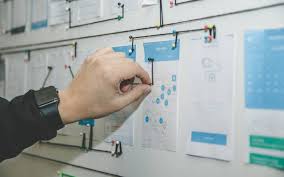Medical transcription is the process of converting voice recordings of doctors and other healthcare personnel, into written text. There are several differences between medical transcriptionists and coders. This job requires a variety of skills to carry out their responsibilities correctly
Medical Transcription
A medical transcriptionist, also known as a “transcriptor,” is tasked with listening to audio recordings from medical specialists like doctors and typing and organizing medical documents. In addition to typing a variety of medical documents, such as patient reports or public health advice, they are also responsible for communicating with doctors and administrative staff to fact-check information and medical terms. They must also make sure to finish writing assignments for their employer by the deadlines set by their employer.
In order to assist their employer in creating and updating documents from audio formats, medical transcriptionists typically work for a variety of healthcare facilities, including hospitals, healthcare clinics, or private practices. In addition, they may work independently or for transcription services.
They might also be in charge of maintaining databases or digital filing systems so that their employer and the medical team can access well-organized patient records.
A competent medical transcriptionist also knows how to use appropriate abbreviations and medical terminology to produce thorough documents. The ability to spot spelling or punctuation errors on medical documents before publication is another quality medical transcriptionist trait.
You can work from home or in a doctor’s office as a medical transcriptionist. Working from home may entail providing services to a single doctor or organization or serving as a freelance transcriber for numerous businesses. Medical transcriptionists and coders should not be taken as one.
Medical Transcription Job Description
A medical transcriptionist is responsible for transcribing and editing audio files. Other duties include:
- Generating medical reports and records, letters to doctors, patient information, and other administrative materials like statistics and patient data
- Examining and correcting transcriptions for clarity, grammar, and appropriate use of medical terminology
- Keeping track of medical records, including medical histories, in databases and files
- Transcribing medical records from providers’ recorded messages includes writing up medical reports, summaries, office visit notes, and other types of medical paperwork.
- Publish transcribed documents online for doctors or other providers to review and sign, making any necessary corrections or changes.
- Accuracy requires knowledge of medical jargon, sentence structure, and proper grammar, spelling, and punctuation.
- Receive clients, schedule appointments, and maintain patient records
- Utilize a variety of transcription tools, such as word processing and computer software, and speech recognition devices.
- Adhere strictly to provider standards and legal requirements regarding patient confidentiality
- Making use of electronic health record (EHR) systems, creating templates, and entering data to maintain current records and archives.
Medical Transcription Certification
Along with teaching students how to type, edit, and proofread documents, transcription education also covers information management. Medical transcriptionists can better understand their jobs as medical professionals with the help of classes in anatomy, physiology, and medical terminology. The Certificate Program Approval Committee offers voluntary accreditation.
There is a connection between these initiatives and the American Health Information Management Association. Additionally, transcriptionists can earn certificates for Certified Medical Transcriptionists and Registered Medical Transcriptionists. High school graduation and the CMT certification are prerequisites for this position. Successful medical transcriptionists have solid computer skills as well as superb listening abilities.
Medical Transcription Salaries
In the United States, a medical transcriptionist can expect to earn a total of $51,022 per year, with an average wage of $48,308. Depending on where you live or how much experience you have, the exact amount may change. Three to five years is the typical length of employment in this position.
Medical Transcriptionist Skills
Medical transcriptionists require a variety of skills to carry out their responsibilities correctly. A few of the abilities are:
- Referencing medical dictionaries, drug reference books, and medical books to ensure that the terminology and spelling of medicines are accurate.
- Understanding of word processing software, audio software, and foot pedals for transcription
- Communication abilities for sharing patient information and work assignments with healthcare professionals and patients
- Having good time management and organization skills is essential when working on multiple transcription projects at once.
- A thorough understanding of medical jargon and terminology to fix transcription errors
- Ability to maintain the privacy of patient information
- Knowledge of Microsoft Office, EHR, and speech recognition programs
- Prior employment in a hospital or other healthcare facility
- A strong ability to communicate both orally and in writing
- Medical transcriptionists must hold CMT certification.
- Excellent critical thinking abilities
- The capacity to perform well and thrive under pressure
- Dependable and on-time attitude
- Excellent time management and listening skills
- Typing at 90 WPM
- Understanding of technology
Medical Transcription vs Medical Coding
There are clear lines of distinction between medical transcriptionists and coders. they include the following:
Medical transcriptionists translate audio recordings of patient care into written notes that are then added to a patient’s file, often in cooperation with doctors and other healthcare professionals. On the other hand, medical coders work with those files, making sure they are up-to-date and compliant with insurance and governmental regulations.
Another difference between medical transcriptionists and coders is that medical coding assigns alphanumeric codes to illnesses, wounds, and therapeutic interventions. Submit claims for payment and give providers advice on proper documentation. While transcriptionists listen to audio recordings made by physicians and other healthcare professionals and turn them into written reports, they also edit drafts produced by speech recognition software for accuracy and style consistency, find inconsistencies or errors, and follow up with medical professionals
Medical transcription entails translating laboratory results or other written medical information. Medical coding, on the other hand, is the process of transforming prescriptions for medical data into numeric or alphanumeric codes to aid in the medical billing process. The above is one of the differences between medical transcriptionists and coders.
What Qualifications Do I Need to Be a Medical Transcriptionist?
If you have a GED or high school diploma, you can work as a medical transcriptionist. However, some people choose to continue their education. Even while you’re still earning your degree, you could begin working as a medical transcriptionist. Enroll in an associate’s degree program in medical transcription, many of which are self-paced online programs. Finish your coursework to receive your diploma.
The ideal prerequisites for a medical transcriptionist are graduation, a solid command of English, and preferably enrollment in a medical transcription (MT) training program. Most institutions demand at least a 10+2 with an English Comprehensive in order to enroll students in medical transcription programs.
The majority of medical transcriptionists require postsecondary education leading to a certificate. The fundamentals of anatomy, physiology, and grammar must be understood by aspiring medical transcriptionists. Some decide to pursue certification
Is It Hard to Be a Medical Transcriptionist?
The work demands accuracy and is challenging. Doctors who vocally record their notes for a transcriptionist don’t always consider the person who will be reading what they say because audio files are not always free of background noise and are frequently difficult to transcribe.
What Are the 3 Most Important Skills of a Medical Transcriptionist?
Success as a medical transcriptionist requires a command of the English language, familiarity with medical terminology, and a rapid typing pace.
Additionally, medical transcriptionists should be comfortable creating reports using software and have some knowledge of electronic health record (EHR) systems. Medical transcribers must evaluate medical reports and revise any errors, or inconsistencies in final drafts.
How Do I Start Medical Transcription?
#1. Earn a Ged or High School Diploma.
To work as a medical transcriptionist, you need to have a high school diploma or GED. You can start your career as a transcriptionist by earning a high school diploma or GED.
#2. Calculate Your Typing Speed
Your ability to earn more money from medical transcription depends on how quickly you can type. Although 40 words per minute (WPM) is a respectable starting point, if you want to be able to earn more money, you should aim for at least 80 WPM. You can find a variety of typing assessments online, as well as training materials, to help you improve your speed.
#3. Obtain a Medical Transcription Certificate
The Association for Healthcare Documentation Integrity (AHDI) has a list of programs that have been approved to teach medical transcription. Even though getting a certificate in medical transcription is optional, it will increase your knowledge and give you a competitive edge.
#4. Be Familiar With Medical Terms
The AHDI-approved certificate program will teach you a lot about medical terminology, but the more familiar you are with it, the more useful and effective you will be.
#5. Obtain RHDS Certification
To work as a medical transcriptionist, you can earn one of two credentials. The first qualification is being a Registered Healthcare Documentation Specialist (RHDS). New medical transcriptionists with under two years of experience are eligible for this certification.
#6. Gain Experience
You can benefit from opportunities for freelance transcription to develop your skills. Additionally, you can apply for a job at a hospital or a work-from-home position that uses a particular hospital. However, the majority of these organizations prefer to work with medical scribes who have more experience and who are Certified Healthcare Documentation Specialists (CHDS) certified.
#7. Obtain CHDS Certification
You can prepare for your Certified Healthcare Documentation Specialist (CHDS) test by taking practice exams after you’ve had at least two years of experience. Your advanced understanding of medical jargon and your capacity to use specialized reference materials will be put to the test on the CHDS exam. You can obtain the skills you need to pass this test by enrolling in certificate programs and working as a freelance transcriptionist.
Does Medical Transcription Pay Well?
As of February 8, 2023, the US average salary for a remote medical transcriptionist is $52,761. That comes out to about $25.37 per hour, in case you need a quick salary calculator.
Can You Be a Transcriptionist Without Training?
Being a transcriptionist does not require any kind of degree. It is advised to take a professional transcription course to learn the ins and outs of the field.
How Do I Train to Be a Transcriptionist?
- Typing exercises Make it a point to type at least 60 words per minute (WPM) even though the majority of transcriptionists can only do around 50 WPM.
- Transcribing a Wide Variety of Audio.
- Continue to increase your typing accuracy and speed.
- Train yourself to transcribe content that is industry-specific.
- Check for Common Errors.
Conclusion
They collaborate closely with doctors, nurses, and office staff to confirm patient information and other details that will help their reports. Their role involves utilizing various technologies, such as software for medical transcriptionists, to assist in the creation of medical documents.
Medical Transcription FAQs
What Is Medical Transcription?
This is the process of converting voice recordings of doctors and other healthcare personnel, into written text.
What Are The Skills for Medical Transcription?
- Fast typing abilities
- Keen listening ears
- Knowledge of Microsoft Office, EHR, and speech recognition programs
- Thorough knowledge of medical terminology
Can You Be A Transcriptionist Without Training?
It is advised to take a professional transcription course to learn the ins and outs of the field.
Related Articles
- BECOMING A TRANSCRIPTIONIST: Complete Blueprint
- ONLINE JOBS FROM HOME: Best Online Jobs for Beginners
- What Is Pmp Certification: What They Do, Requirements, Cost & Training
- 5 Reasons Why You Should Consider a Career in the Medical Field
- Best Certificate Programs That Pay Well in 2023
- WHAT IS DRUG SCREENING: Meaning, Need, and Methods






